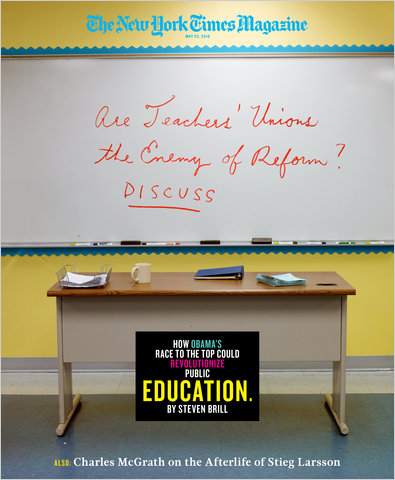 The New York Times Magazine published a terrific piece about education reform yesterday. The Unions have so much power that we do not often see clearly articulated arguments like this in the mainstream press. In case you are new to this fight, here is a quick list of the codes used:
The New York Times Magazine published a terrific piece about education reform yesterday. The Unions have so much power that we do not often see clearly articulated arguments like this in the mainstream press. In case you are new to this fight, here is a quick list of the codes used:
Resources: The most frequently misappropriated term in the debate is Resources. To most this implies funding, and we do need to increase school funding. However, to the unions this means dues. Since union dues are by headcount the unions want more headcount regardless of the quality. Smaller class sizes means more headcount. Clearly there are benefits to smaller class sizes, but all of the studies now show that better teachers are much more important.
Measurement: Next on the hot list is measurement. Standardized tests do create all kinds of warped behaviors and this needs to be addressed. In business we know that there is no single good performance measurement, but we also know that things need to be measured -- the more the better and the more the data is shared the better. The unions not only oppose measurement, but also oppose better data systems that would make it easier to expose performance data. In most states this opposition has made it hard to track students even crude measurements like grades, activities, and attendance.
Charter Schools: The NY Times article said it better than I can:
Charter schools are not always better for children. Across the country many are performing badly. But when run well — as most in Harlem and New York’s other most-challenged communities appear to be — they can make a huge difference in a child’s life.
The article goes on to do a side by side comparison of a NY charter school that shares a building with a public school. The charter school spends slightly less than the public school and performs well above. The customers (parents) have noticed and tens of thousands of students are turned away from charter schools every year because there are not enough charter schools.
In some states (Washington included) the unions have successful blocked charter schools with targeted legislation. It is an effective way to keep the resources out of the hands of people that can make more efficient use of them.
The Obama administration's $4.3 billion "Race to the Top" contest is changing things fast. This is a good example of creative government spending using a relatively small amount of money to make a big impact. In order to be competitive, a state must demonstrate its ability to measure teacher performance and must have charter schools. This does not make things look very good for Washington State, but it is absolutely the right thing for the country.
The tide is turning now and we are going to start seeing the states that figure it out get way ahead of the states that don't. This is very good news for our country because fixing our education system is the single biggest thing we need to do to remain competitive and retain our high living standards.
If you are interested in following along, here are two organizations in Washington State that are making a big impact:
I wrote a book review about Work Hard: Be Nice -- which follows the Knowledge is Power Program (KIPP) and Teach for America.